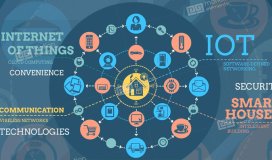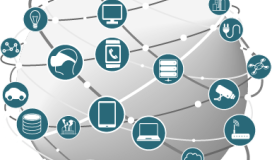The problem with most modern manufacturing environments is that things don't talk to each other. Decision-making is centralized and human-driven, which adds error and reduces speed. Companies like Siemens are changing this reality with Industrie 4.0, a movement to unify physical and cyber-physical systems with the Internets of Things and Services. The desired end result is smart, agile manufacturing environments in which cyber-physical systems perform tasks autonomously, diagnosing and making adjustments as needed. In such facilities, information is shared in real time between cyber-physical systems and humans, ideally both internally and with suppliers.

It's a big job. Developing smart systems that self-diagnose and communicate with each other in real time demands universal standards that apply to many different practices and applications. Industry players like Siemens and Bosch are hard at work putting those very standards together. One constant in such environments is RFID-a technology that brings real world advantages to IT systems.
"Modern systems will create a digital twin of a product, of a plan, of everything that needs to happen system-wise," explains Markus Weinländer, Head of Product Management for SIMATIC Communication Products at Siemens' Process Industries and Drives Division. "But there is always discrepancy between an ideal digital print and what is happening on the shop floor."
Weinländer explains how RFID is used to synchronize the ideal scenario with reality-by finding discrepancies through tracking. "Manufacturing environments with IT systems, especially those that take big data approaches, need to collect information automatically and synchronize plans with what's happening on the factory floor." RFID performs several functions in this respect: collecting sufficiently detailed data to enable analysis and prediction, and making sure that reality jibes with that prediction. "The more information you have in the cloud," continues Weinländer, "the greater the need for synchronization in factories."
Tracking supplies, equipment, inventory and the evolution of a finished product forms a big part of ensuring efficiency. Imagine a complex manufacturing environment-aerospace for example-in which there are 10,000 distinct component SKUs, yet there is never a shortage in supply and consequently no work stoppages. Each work area, tens of square meters in size, is replenished as soon as available components reach a minimum number. As RFID tags are read and machining specs change, machines adjust automatically to exactly match the new specs. Such scenarios are possible because RFID inputs have evolved from fixed readers to networked fixed readers, and then to networked area readers.
"This is happening now-it's not new news," says Atte Kaskihalme, Business Area Director for Nordic ID. "We have reached the stage where you can track everything all along its journey through a manufacturing environment, from components to finished products, from tools to uniforms and containers."

Some companies are using RFID's tracking abilities to provide value-added services. A European uniform rental company, for instance, leverages RFID to offer a paid on-premise security checking service that ensures all of their customers' workers end up with the right gear every day.
Kaskihalme likens what's happening in RFID to telecom. First there were fixed systems. Then the Internet came to public telephone networks, closely followed by local private networks, which became VOiP-enabled. Now Europe and other jurisdictions are approaching a uniform VoIP-based system. As that has happened, the role of the telcos has changed. They are no longer selling and installing PBXs or sending workers out to make moves, adds or changes. Now they mostly just sell services.
RFID is moving in the same direction. In the early days, separate readers were connected to local systems. Then fixed and mobile readers began to share the same network, talk the same language, collect data together and provide complete visibility. "Where we see the industry moving next," predicts Kaskihalme, "is into value-added data analytics services." In this nascent Internet of RFID readers or 'IoRFID', pre-filtering and analysing all this data can add tremendous value to a manufacturing environment. Remotely controlled fixed reader networks, supplemented with data from handheld readers, can deliver use case-specific data via cloud-based services to help increase efficiency, build added agility or predict future needs.



